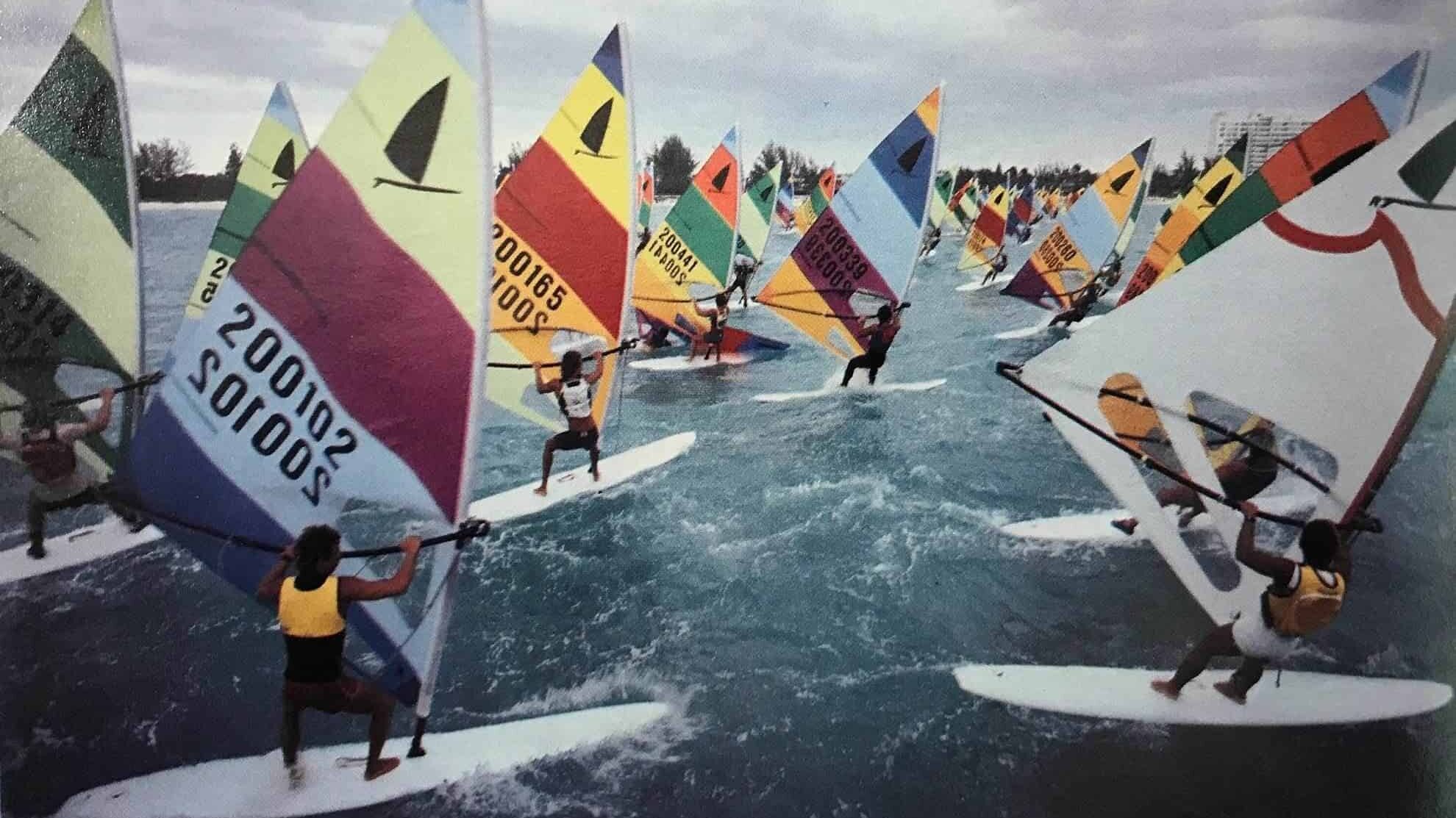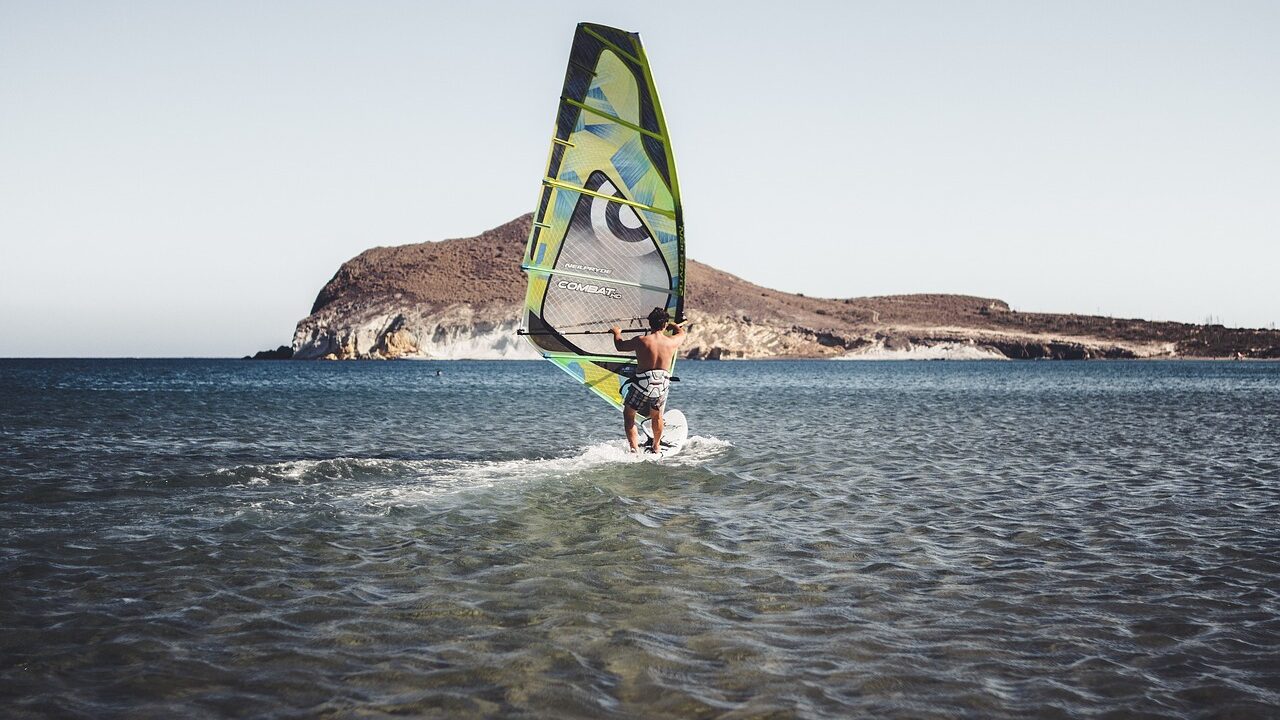
Table of Contents
Imagine yourself sailing smoothly on the water surface, feeling as if you were shot behind by the wind that was now carrying you forward while you were on a windsurfing board. It is a tremendously exciting phenomenon that aspires to thrill and diverts all the attention of adrenaline-lovers and water sports addicts.
Windsurfing, which is both breathtaking and made up of sailing and surfing, has grown into a hugely popular and loved sport. While the roots of the concept are both entangled and intriguing, these mysteries remain unsolved, with the query about the original creator and the way the idea has developed over the course of history still unanswered.
As we take up windsurfing’s history in this article, we will explore the inspirations from Hoyle Schweitzer and Jim Drake, understand the milestones that made the sport thrive, and, of course, the legacy the community has grown into.
Who Invented Windsurfing?
For a new hybrid water sportsman, dinghy represents the most basic gear. Windsurfing, a sport that borrowed elements from sailing and surfing and came into existence subsequently by a couple of innovators, became a popular sport in many countries. His attributing role in its invention and creation is acknowledged most by Hoyle Schweitzer, a trained aeronautical guy, and Jim Drake, an ocean surfer and sailor.
They passed through the late 1960s and early 1970s working side-by-side on the concepts, and together they accentuated the design by making sections, such as masts and universal joints, that aided in mobility and control. With Hoyle’s engineering expertise and the raw passion of Hoyle, their teamwork led to a patented “Windsurfer” prototype in 1973, on which the seemingly simple yet captivating modern windsurfing epics were built.
When was windsurfing invented?
Windsurfing, due to its variability as an activity, started as a sport in the early 1970s. The apex moment dawned in 1967 when Jim Drake filed a patent for sailboards, which was followed by Hoyle Schweitzer, who filed another patent for his design. After those initial designs were continually modified, the iconic “Windsurfer” board became patented in 1973.
This took place on this particular day, which stood as a starting point for windsurfing as an acknowledged sport. Since then, the sport has changed in a big way. No wonder that the equipment and the techniques have evolved and contributed to its development.
What Is The Birthplace Of Windsurfing?
Windsurfing’s origin can be drawn back to Southern California, and mainly during homelessness, or lack of one, that is homelessness. The coastal region was the place where dedication and hard work resulted in the DIY spirit which allowed early windsurfing pioneers like Jim Drake and Hoyle Schweitzer in the late 1960s and early 1960s to launch their boards from the field to the water.
With air being the persistent factor and water bodies readily testable, the sport became ideally suited for development by modifying the set of gears and techniques. This spot in the annals of the windsurfing’s history is of great importance, as it became a foundation for the world-wide fame as well as the sport’s further development.
Milestones in The History of Windsurfing
1960s: Inception and Development
In the 1960s, dynamic watersports brought up the birth of windsurfing. People of that time were on the move, testing the possibility of installing sails against surfboards, looking to achieve efficient management of stability and practicality. At the end of the decade, the windsurfing industry had its breakthrough when the first non-death leisure boards became publicly available, opening the gate for everyone who wanted to try something new and exhilarating.
This era was marked by a memorable feat: the name of the inventor was Hoyle Schweitzer, and Jim Drake patented the windsurfer design in 1968. The Windsurfer (a development of the SURF95) was, in time, mass-produced with its universal appeal and user-friendly design, which artists like Francois, Jacques le Moigne, and Agazzi made possible. This standardization was a big factor in introducing windsurfing into the spotlight, which exhausted the categorization of windsurfing from a water sport for certain individuals to one for the masses.
1970s: Global Recognition
Recognition of windsurfing as an official sport by the world took place in the 1970s, as the sport was transformed from just an experimental hobby to a serious career with many competitions. In addition, organized windsurfing contests were being held, in which sporting men and women were showing flashes of what they could do best. They not only worked to enhance a windsurfer’s intensity; they also generated colorful social networks around the planet.
The defining turning point in the history of windsurfing was actually reached in 1973, when the Windsurfer was featured at the LA Olympics and the event was given the status of a demonstration event. Though not yet a recognized Olympic event, the upsurge in its popularity following its appearance on an international platform markedly made windsurfing more notable, drawing over a large number of those thrilled by the energetic dyna

1980s: Windsurfing Goes Mainstream
The arrival of the 1980s was a time when windsurfing absorbed the spotlight and permeated the public consciousness. During the events of the 1984 Summer Olympics, windsurfing officially made its Olympic debut as the games in Los Angeles proclaimed the sport a competitive and well-known water activity across the globe.
Technological advancement, being the major contributor, brought about a great change in society. With every revision in the board and sail design, as well as the development of new materials and constructions,wider riding variety and performance were achieved. Just like easier—one time in the past, windsurfing was an exclusive occupation—in the present situation, it has turned into an energetic, commonly known activity for lovers of waters everywhere.
1990s: Evolution and Diversity
The windsurfing of the 1990s has made some remarkably good progress and has become much more diverse because of its high diversity. The discipline of freestyling windsurfing became competitive and started distinguishing the riders by their ability to perform acrobatic figures and create a range of other principles. Specialized boards and sails were created for varying situations and styles that consequently enhanced the variety of conditions and the nature of the ways the sport could be performed.
Environmental advocacy was also the major discourse as far as this era is concerned. The windsurfing community started to shift toward actionable preservation, citing impending greater global movements such as environmental sustainability. To a great extent, the sport participates in environmental-friendly events and competitions, which only shows the roots of its commitment to preserving the natural environments within which the cricketers thrive.
2000s: Technological Advancements and the Global Community
The 21st century ushered in an avalanche of technological improvements in windsurfing equipment. Lighter materials, such as foam, carbon, or Kevlar, joined with curvy shapes and hydrodynamic design, improved the acceleration and agility of the boards and sails. The hydrofoiling technique was introduced to create a surface above the water; this has decreased the appeal of the sport to both experts and novices.
The development of the windsurfing community worldwide, as a result of the impact of online platforms and forums, nevertheless continued to increase. The dissemination and exchanging of the know-how, the experience that we were all sharing, and the diversity of the sport spirit were what made this culture so popular in the world. The decade of the 2000s was one where windsurfing spruced up into both an activity and a global community brought closer together by wind and water sports.
Challenges and Innovations
The development of windsurfing is no doubt related to the advances in technology, and technologies influence the direction that sport is taking. The increasingly accurate improvement in the materials and methods of construction has led to more intelligent, lively, and swift boards and sails.
The development of carbon fiber, for instance, sparked the once-major transformation of the industry. This new, improved material strikes the ultimate balance of strength and weight. Besides, the introduction of foiling technology represents a new era for windsurfing enthusiasts due to the fact that it makes windsurfing boards float above the water surface, which formerly had intriguing and speedy movements.
Because the economy has given its share of problems, but the windsurfing community has shown its toughness in the past. There was a need for manufacturers to innovate, and they did it by looking for ways to make their products cost-efficient and accessible to consumers. Second-hand markets and programs for renting gear have brought about more democratization of access to that sport, enabling impoverished people to participate in the sport without having to spend an amount that takes to themselves a large part of their income. On the one hand, environmental confidence has additionally benefited the fashion industry, whereby designers utilize eco-friendly materials and reduce the amount of waste produced during fashion production.
Trailblazers and Icons of Windsurfing
Windsurfing has plenty of sources for its numerous histories, and this includes pioneers and innovators who have shaped the sport from its inception to the present day. Hoyle Schweitzer and Jim Drake are known as the designers of the windsurfing hallmark, which also happened to be its standardization for the masses. This way, windsurfing became a call that spread across the globe. Founding the windsurfing community we know today (or simply “the windsurf”), their ingenuity paved the way.
Although the years have passed, windsurfing originated with different generations of athletes who spiced up the sport with their typical new heights’s records. Sailors like Robbie Naish, who often goes by the nickname “Windsurfing’s Ambassador,” are the true champions who’ve not only surpassed their competition but have also heavily influenced the design advancements specific to the field and have made the sport more familiar among people in general. Star players like Björn Dunkerbeck and Sarah-Quita Offringa, through their outstanding abilities, have made their own contributions to windsurfing, probing the boundaries and developing the sport further in their own categories.
As we look up to these trailblazers and icons whose stories continue to inspire us, these stories not only show us how windsurfing changed from a sport to a way of life but also how this sport transcends beyond recreation to social interactions. Through their passion and hard work, they have helped the community become the vibrant and diverse one it is today. They stand as a proud testimony for many youths around the world.
Conclusion
Finally, after an excursion down a historical track that traces more than a few decades, we find ourselves caught up in a tale that includes many renewals, zeal, and, latterly, a global community. From the earliest days of surfing and kitesurfing, 1968 being the birth year of the windsurfer, to the modern and famed watersport enthusiast because of its inclusive nature, windsurfing has evolved through the years to become a dynamic water sport enjoyed by enthusiasts from all over the globe.
How old is windsurfing?
In order to get the meaning of the question, “How old is windsurfing?” we begin where its inception is sure to be—the efforts of individuals like Hoyle Schweitzer and Jim Drake dating back to the late 1960s. The windsurfer brought forth the standardized design of the craft that officially marked the birth of modern windsurfing, meeting the people’s demand for fun and adventure. In this sense, contemporary windsurfing evolved over the course of more than 50 years, the history of which is characterized by the increments of the preceding generations and the efforts of many people; this legacy transported it into the 21st century.
Windsurfing has made it so clear that it is not just another sport capable of coping with economic changes, but also of being open to digitalization and uniting people in one community thanks to their mutual affection for the wind and the sea. Windsurfing has had to deal not only with economic issues based on market changes but also with modern environmental awareness, which is becoming as necessary as ever.
On the lookout for the future, windsurfing is taking first place in the world of water sports, along with keeping up with trends that will become a new trend. The influence of trend-setters from the right areas, ranging from inventors to sailors, also remains a freedom-giving force for the present generation, and as a result, the spirit of windsurfing is immortal.
For those seeking more adventures on the water, consider exploring the physical benefits of surfing and how it complements the windsurfing experience. Check out our article on How Many Calories Does Surfing Burn? to discover the fitness aspects of these exhilarating water activities.

